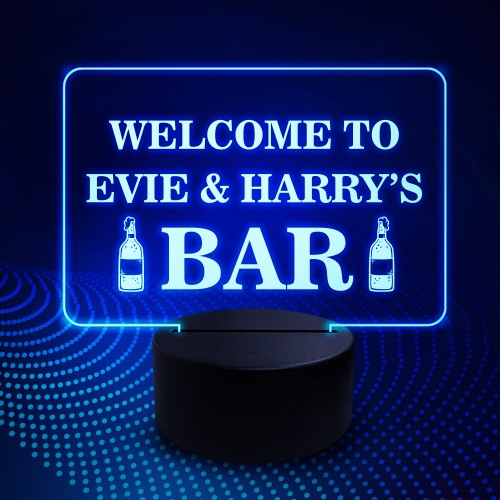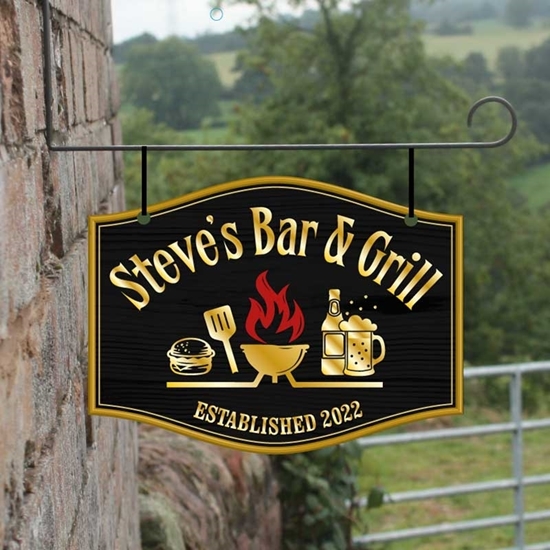The dimensions of bar signs vary depending on the intended purpose and their position as well as the overall design aesthetic. The following are the ways that different sizes impact bar signs with regard to functionality and design. Large Signs
Use to bring attention to an location and act as an important focal point.
Uses External branding, main brand signs or feature walls.
Placement is typically in front of entrances, outside bars, or on large wall surfaces to attract patrons.
Examples include large neon signs in vintage-style, large-sized mural signs, and vintage-style signs that are large in size.
2. Medium Signs
Uses: To provide information or decorate the space without being overpowering.
Uses: menu boards, displays for promotions and signs for directional purposes.
Placement: Positioned within easy view, but not overwhelming for example, behind the bar, over seating areas, or on feature walls.
You can use decorative signs or metal signs to advertise your bar.
3. Small Signs
Use: To add small details or details.
They can be used for table signs, small decorative items or labels.
The table or on shelves in which close-up viewing is desired.
You could use small quotes or drink menus for an example.
Size Aspects
Visibility
Signs that are big They can be seen at a distance and draw attention of passers-by. They also signalize the presence of the bar.
Medium Signs: Balances visibility and space efficiency, delivering vital information, but not overwhelming the décor.
Small Signs: Ideal for intimate details or close-ups. Enhances the customer's experience by placing them near the eyes.
Proportion
Large Signs: Must be in proportion to the area to avoid overwhelming smaller areas. Ideal for large, open areas.
Medium Signs: They work well in most interior spaces, providing flexibility in its placement.
Small signs: Ideal for adding detailed touches and fitting into tighter spaces without causing clutter.
Impact
Signs that are large in size makes a bold and strong statement. This can be an important factor in branding. It is often used to create a atmosphere for a bar.
Medium Signs: Achieves an ideal balance between decor and visibility, all while providing crucial information.
Small Signs: These signs add detail and charm, creating an incredibly rich and multi-layered visual experience.
Practicality
Large Signs require a significant mounting and is more expensive as a result of the size.
Medium Signs are easier to put up and relocate. They also provide the flexibility to make design modifications.
Small Signs. Very versatile, simple to update and replace. Ideal for dynamic environments.
Functionality
Large Signs : They are designed for visibility, attraction and the ability to function.
Medium Signs - They're both practical and attractive. They give you essential information as well as enhancing your visual.
Small Signs can be used to provide detailed information. They can also be used as a way to create a subtle décor and theme.
The ideal size for an appropriate bar sign is dependent on its intended purpose, the layout of space and the impression desired by the patrons. Make sure to balance these factors so that the signs contribute to the atmosphere of the bar and its operational needs. Have a look at the most popular read what he said for cocktail bar sign for website examples including bar signs for home, hanging pub signs personalised, personalised hanging pub signs, personalised metal pub signs, home garden bar signs, personalised signs for home bar, garden bar sign personalised, outdoor home bar signs, personalised sign for bar, pub signs for garden and more.

How Can The Reading Ability Of The Bar Signs Differ?
The ability to read bar signs is affected by a variety of factors, including the font size, font and contrast in color, lighting and position. This article will explain the ways in which each of these variables impacts the readability bar signs. Font Choice
Specifications: The typeface used for the sign.
Choose simple sans-serif fonts like Arial, Helvetica or serif fonts such as Times New Roman.
Stylized Fonts: Decorative or script fonts are harder to read, especially from a distance or in low light.
Impact: Clear, legible typefaces allow patrons to quickly and effortlessly comprehend the content.
2. Font Size
The sign's characteristics include The size of the text.
Large Fonts: Readable from a distance, perfect for main and exterior signage.
Small fonts are ideal for tablestop signs, menus and other displays that are close-up.
Impact: The right font size is crucial for reading at different distances. Larger text is more easy to read from a distance.
3. Color Contrast
Characteristics: The difference in color between the text (text) and the background.
High Contrast is dark text on a white background or light text on black background.
Low Contrast: Background and text colors that are similar can cause difficulty in reading the text (e.g. grey on black).
The high contrast of text makes it readable and helps to make it stand out.
4. Lighting
Particularities: The manner in which the sign is lit.
Well-Lit signs: Backlit and front-lit signs increase visibility in low-light conditions.
Poorly lit signs: Signs that are not adequately illuminated can be difficult to spot at night, or even when dimly lit.
Effective lighting: Proper illumination will ensure that the signs remain easily read and clearly visible in low-light environments.
5. Material and Finish
Particularities What is the material used color, finish and type of material used to create the sign.
Matte Finish : Limits reflections and glare, making it easier to see the text.
Glossy Finish - May cause the appearance of glare when exposed to direct light which can make it difficult to read.
Effect: Selecting the best material can enhance reading because it reduces glare.
6. Text Layout
Specifications: Text layout on the sign.
Clear Hierarchy: Use headings, subheadings and body texts to help arrange your data.
Unorganized layout: A sign that is difficult to read can be cluttered with a lot of text or have a design that's overly complex.
Impact The clear and well-organized layout will help patrons find the information they need quickly.
7. Viewing Distance
Specifications
Larger fonts and a high contrast font are crucial to read long distances.
Short distance: A shorter text is fine as long as it remains clear and simple.
Impact: Signs are created to be read with the reading distance that is intended in mind.
8. Placement
Characteristics: the physical place of the sign inside the bar.
Ideal placement: near the eye, not obstructed and well-lit.
Poor Placement: Up high, obstructed by objects, or in poorly lit areas.
Impact: The location of signs ensures they are easily read by visitors.
Examples of Bar Signs
Exterior Signage
Characteristics include: Large, high-contrast text that is well-lit (e.g. neon or backlit), and placed prominently.
Impact: Draws attention and is easily readable from a distance, drawing at customers.
Menu Boards
Characteristics of a chalkboard or backlit board include high-contrast, clear headings, large font for item names and good lighting.
Impact: Simple to read for patrons and it is easy to decide on their order, improving the overall experience.
Directional Signs
Specifications: Clear and large text with simple Arrows. High contrast. Strategically placed to be at eye level.
Impact: Improves efficiency and overall satisfaction of patrons by helping them navigate through the space.
Promotional Signs
Specifications: Bold text for advertisements, high contrast, well-lit, placed in areas with high traffic.
Impact: Effectively announces special events and discounts in a way that encourages customers to participate.
Factors Affecting Readability
The environment can influence how easily signs are read. Ambient lighting, ambience of the bar and its overall appearance all affect this. It is simpler to read signs in well-lit areas.
Patron Movement - In busy bars, the signs must be easily understood by patrons who are moving around. Text that is large and with high contrast could be helpful in these situations.
The frequency of updates is important for signs such as daily specials. Formats that can allow for regular updates and allow for readability (e.g. chalkboards or a digital display) are essential.
By making sure they pay attention to these elements bar owners can ensure that they have signage that is not only visually appealing but also legible, improving the overall customer experience. View the recommended helpful resource for more examples including hanging home bar signs, bespoke bar signs, home pub signs, outdoor home bar signs, bar sign design, pub signs personalised, personalised home bar signs, the staying inn bar sign, sign for garden bar, pub signs to buy and more.

What Is The Distinction Between Interactive Bar Signs As Opposed To Other Signs For Bars?
Bar signs can incorporate various levels of interaction to entice patrons and improve the overall customer experience. Bar signs can be classified according to their level of interactivity. Static Signs
Static signs are a classic method to communicate information. They do not include any interactive components.
Common types: printed posters, murals painted or traditional neon signs.
2. Digital Displays
Digital signs are capable of displaying live content, which includes animations, multimedia and updates.
Interactivity: Touchscreens may include interactive games, menus, or promotional content.
Benefits: Draw the attention of customers, communicate dynamic information, and encourage customers to be more engaged.
3. QR Codes
Interactive Links QR codes on signs can open menus as well as social media profiles and promotions.
Benefits: Give quick access to information regarding promotions or loyalty programs.
4. LED Screens
LED screens display animated text, video as well as animations.
Interactivity: LED screens that are touch-enabled allow patrons to interact with content including choosing menu items or playing games.
Benefits: Attract attention to the content, create an immersive experience and communicate information effectively.
5. Projection Mapping
Immersive experience: Projection maps transform surfaces into dynamic displays and interactive images, allowing for storytelling.
Interactivity: Patrons are able to interact with projections, such as virtual games, interactive ones or even.
Benefits: Improve the ambience and increase social interaction.
6. Augmented Reality
AR (Enhanced Reality) overlays digital content onto the physical environment to provide interactive experiences.
AR enabled signs enable customers to interact virtual elements such as cocktail recipes or virtual games.
Benefits : Create a unique experience, engage your customers and distinguish yourself from your competitors.
7. Motion Sensors
Motion sensors are utilized to detect movement in signage and trigger interactive responses.
Signs are interactive and respond to the movement of the patrons through displaying animated content, changing its content, or even displaying customized messages.
Benefits You can create immersive environments that delight and surprise your patrons.
8. Social Media Integration
Interactive Online: Signs could contain hashtags or handles for social media to encourage patrons to engage on the internet.
Users-generated content: Inspire customers to post photos of your signage on social media to increase the visibility and reach of your establishment.
Benefits: Increase brand recognition and encourage community involvement.
9. Interactive Lighting
Dynamic Effects LED or Neon Signs with Interactive Lighting are able to respond to Sound, Touch, or motion.
Signs are interactive and can alter colors, brightness levels, or patterns, depending on how patrons interact with them or the environment.
Benefits: Create immersive environments, enhance ambiance, and draw the attention of.
10. Gamification
Signs with Interactive Games or Challenges: These signs include interactive games and challenges that entertain the patrons and inspire their participation.
Offer freebies and discounts in order to encourage players to complete challenges and play games.
The benefits include: extending dwell time, fostering social interaction, and encouraging repeat visits.
Incorporating interactive elements into their signage bars can create interactive experiences that captivate patrons and help build brand awareness and distinguish their establishment from a competitive market. Have a look at the most popular cocktail bar sign recommendations for website tips including hanging pub signs personalised, indoor bar signs, staying inn sign, bar signs for home bar, pub sign hanging, personalised outdoor pub signs, pub wall sign, personalised pub, to the bar sign, pub sign hanging and more.
